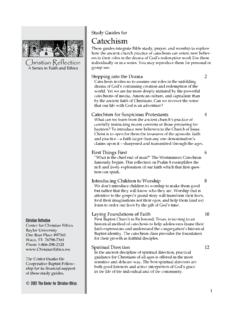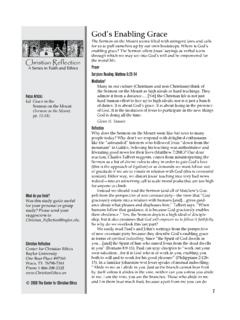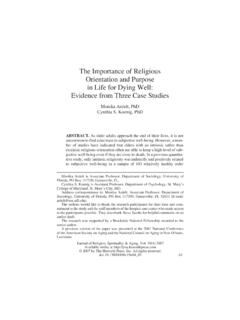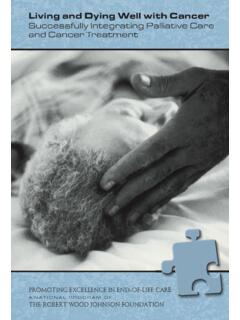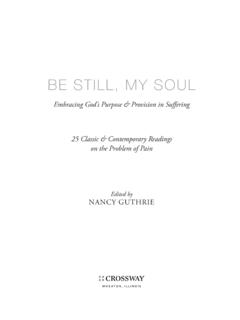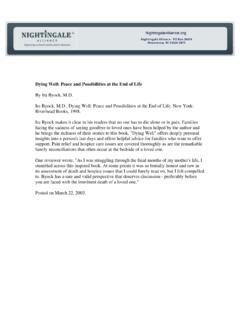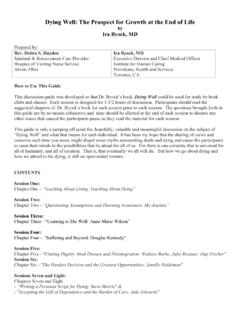Transcription of The Virtues for Dying Well - baylor.edu
1 26 2013 Center for Christian Ethics at baylor University The Virtues for Dying WellBy Brett McCarty and allen VerheyWith the Ars Moriendi tradition, we should focus on the paradigmatic significance of the death of Jesus in order to learn how to die well . We would learn faith, hope, patient love, humility, serenity, and courage as we commend our lives and our deaths into the hands of a living typical Americans how they would prefer to die and they are likely to say quickly, painlessly, and in their sleep that is, if they have even given much thought to their own death. For many, Christian or not, the thought of Dying under the fluorescent lights of a sterile ICU, hooked up to countless machines, is the stuff of nightmares. This lingering and dehumanizing process is instinctively understood as a bad way to die, but often we do not have the imagination to offer a robust alternative.
2 So we try to avoid the process of Dying altogether, preferring either an unconscious demise or, as some recent polls indicate, a quick and controlled death through physician-assisted suicide. If we are honest with ourselves, however, we recognize that this escapist impulse does not serve us very well . A good death, if any death can truly be called good, occurs when one dies at peace with others and with God, and this peace is hard to find in the modern ICU or in sudden deaths. Modern medicine s emphasis on technological progress and patient autonomy offers little in the way of fostering this kind of peaceful order to find resources for a good death, Christians can learn from the riches of their tradition. In particular, we can turn to the fifteenth century and to the Ars Moriendi, a self-help handbook for Dying well in an age filled with the specter of death.
3 Numerous editions of this small pamphlet were published and read This literature did Christians a great service, The Virtues for Dying well 27for it identified the process of Dying as suffused with theological and moral significance, not simply as a medical event. Viewed in this light, death is something that we can and should prepare for as part of a faithful life of discipleship. Ars Moriendi assisted in this process by naming the temptations that the Dying would face, and it recommended particular Virtues to combat these evil inclinations. In intricate woodblock carvings, these scenes of temptation and their corresponding Virtues for Dying well were visually rendered. Moreover, the Ars Moriendi literature emphasized the paradigmatic significance of the story of Jesus, and it couched the process of Dying within the community of faith.
4 By reading these texts and meditating on their images, Christians could begin the process of preparing to die well , a process that should begin well before death is However, the Ars Moriendi literature is not without its problems. Assuming a Platonic dualism, it commends death as the liberation of the immortal soul from the body. Because of this, it disparages the carnal relations of embodied and communal life and so has no place for lament. This emphasis in Ars Moriendi could lead to forms of alienation not unlike those in modern medicalized Dying . Therefore, a retrieval of the late medieval Ars Moriendi cannot include a dualistic commendation of death, but must instead begin with a holistic commendation of a ConTemporary Ars MoriendiWe would do well to follow the Ars Moriendi tradition and focus on the paradigmatic significance of the death of Jesus in order to learn how to die well .
5 In doing so, we will find the clues to overcome the greatest flaw in that tradition, its commendation of death. This is because attention to the death of Jesus demands attention to his life and resurrection. His life began with the incarnation, as the Word of God took on flesh in a fundamental affirmation of human existence. All things came into being through him, proclaims the beginning of the Gospel of John, and in him was life (John 1:3-4). The same triune God who created all of life and proclaimed it very good was present in every moment of Jesus life. As Jesus announced that the good future of God was at hand, he proclaimed that the cause of God was, is, and ever will be abundant life. So if we disconnect the story of his Dying from the story of his birth and his ministry, we risk disconnecting the passion story from Jesus passion for the reign of God.
6 Similarly, focusing on the death of Jesus distorts his story if we forget the resurrection. The resurrection is not a commendation of death, but is instead a celebration of God s love and power, the love that is stronger than death, the power that defeated death. Therefore, attending to the story of Jesus means that we will begin with a commendation of life. His birth, life, death, and resurrection all point toward the cause of God being life, not this understanding of the story of Jesus in mind, we are now prepared to appropriate the Virtues for Dying well given by the Ars Moriendi 28 Death literature. Each of the Virtues given corresponds to a temptation faced by the Dying , starting with the first the temptation to lose faith. In the agony and loneliness of Dying , faith in God can seem to be a difficult, if not impossible, prospect.
7 During these darkest moments, Ars Moriendi is right to turn our gaze toward the faith of Jesus, who displayed his trust in God and God s cause even unto death. It is important to observe that Jesus is not just an example of faith; in our living and in our Dying , Christians can have faith because of his faithfulness. But his faith is paradigmatic for a Christian s Dying well . In Jesus faithful death, we see that the practice of lament is not opposed to faith. Indeed, his words from the cross demonstrate that the psalms of lament are resources for all who follow him. From his cry of dereliction (Psalm 22:1) to his final words, Father, into your hands I commend my spirit (Psalm 31:5), the psalms of lament are part of Jesus faithful death. Moreover, faith in God meant that Jesus valued God s cause over his own life.
8 Although a contemporary Ars Moriendi should begin with a commendation of life, not death, it is important to remember that though life is a great good, it is not the greatest good. Desperately clinging to one s own survival is not the kind of life God commends. To die well , no less than to live well , one has to care about life, but some things must be cared for more than survival. Even though God s cause seems to be thwarted by the powers of sin and death, we can follow Jesus and know that life, not death, will have the final word. God vindicated the faithfulness of Jesus in the resurrection, and because he was raised, we look to Jesus as the pioneer and perfecter of our faith (Hebrews 12:2) and to his faith as the paradigm for our living and our second temptation faced by the Dying is to despair, and it is met by the virtue of hope.
9 Death threatens not just an end to one s existence but the unraveling of meaning, the severing of relationships, the shattering of hopes. In the shadow of death, hope seems like folly. But the God of Ezekiel who promised to make a valley of dry bones live is the God of Jesus Christ, and the hope of Jesus in the face of death is our hope. Through the life, death, and resurrection of Jesus, God has given us grounds to hope that death will not have the last word in our world or upon our lives. Christians do not deny the awful reality of death, but they do insist that death will not have the last word, that the last word belongs to God, and it is not death but life, not suffering but shalom. With faith in God they share the hope of the Church and of its creed. The Apostles Creed, for example, closes with these words of hope: I the resurrection of the body and the life everlasting.
10 This hope, like the creed, is Trinitarian. Christians hope because they know the faithfulness of the one who made all things, because they know the story of one who was raised from the dead, and because they know a life-giving And because this hope must be fitting to the story given in Scripture, it should not shrink to an egocentric desire for a solitary individual to experience the bliss of heaven. Instead, the scope of Christian hope is nothing less than cosmic. The story begins with the creation of all The Virtues for Dying well 29things and it reaches finally to all things made new. And in light of this cosmic scope, Christian hope is also inalienably personal. The same Son of God who ordered all of creation spoke words of hope to the thief on the cross. As with faith, Jesus words from the cross remind us that Christian hope also makes room for lament, as we decry the ways in which God s good future is still sadly not yet.

